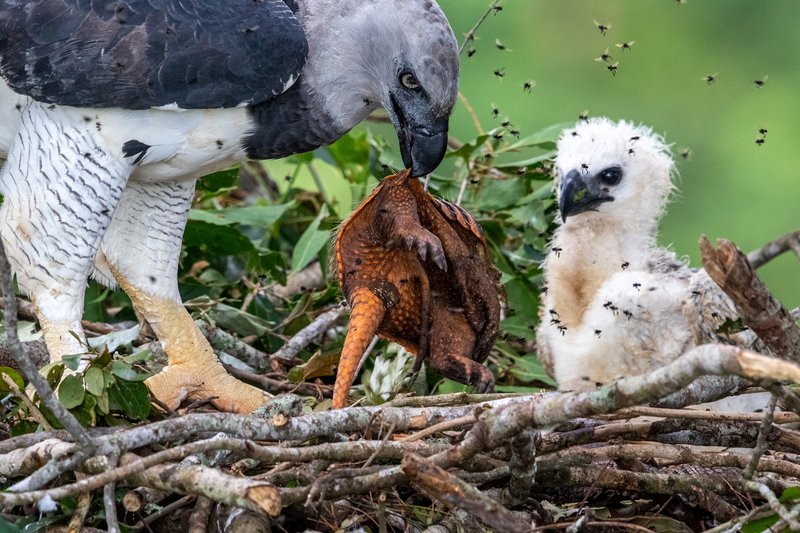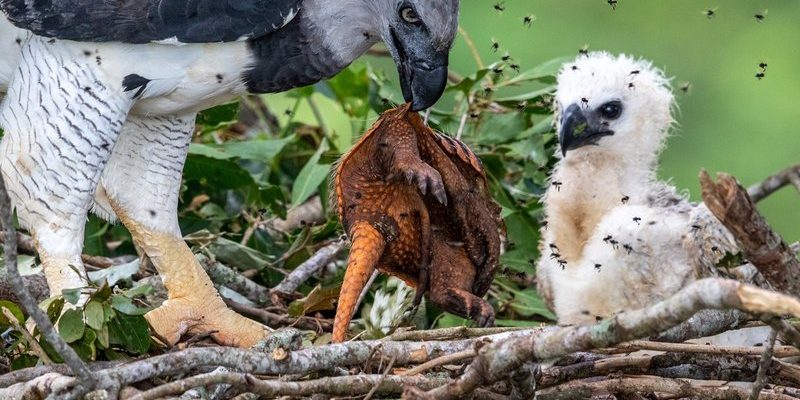
When you think about the eating habits of the harpy eagle, it’s a fascinating mix of power and precision. Known for its large talons and strong wings, this eagle is often found in the lush canopies of tropical rainforests, where it forages for its favorite prey. But what exactly does it eat? And how does it hunt in such dense environments? By the end of this article, you’ll have a clearer picture of the harpy eagle’s culinary preferences and its impressive hunting prowess.
What Is the Harpy Eagle’s Diet?
The harpy eagle primarily feeds on medium-sized mammals and birds. Its diet includes a variety of prey that perfectly matches its size and hunting capabilities. Here are the main components of its diet:
- Sloths: These slow-moving creatures might seem like easy targets, but they often inhabit high trees where the harpy eagle swoops down to catch them.
- Monkeys: Capuchin and howler monkeys are often part of the harpy eagle’s menu. Imagine an eagle snatching a monkey mid-leap between branches!
- Rodents: Small rodents can also be part of their diet, especially when larger prey is scarce.
- Birds: The eagle won’t shy away from other birds, including those that also reside in the treetops.
You might be wondering: how does the harpy eagle choose its meals? Essentially, they typically look for prey that allows them to demonstrate their strength and agility. Given their powerful build, these eagles excel at hunting animals that are about the size of a domestic cat.
How Does the Harpy Eagle Hunt?
The harpy eagle employs several unique hunting techniques that showcase its skill. The first step in their hunting strategy is selecting the right location. Let’s elaborate on how they do this:
- Spotting Prey: Harpy eagles search for their food from high perches in the tree canopy. With keen eyesight, they can spot movements in the underbrush or the treetops.
- Silent Approach: Once they identify potential prey, these eagles glide silently through the branches to minimize detection. Their large wings and strong muscles help them maneuver with incredible stealth.
- Powerful Strike: When the moment is right, they launch themselves into a powerful dive, using their sharp talons to grab their target. Here’s the thing: their talons are incredibly strong, about the size of a grizzly bear’s claws, designed specifically to hold onto live prey.
It’s pretty remarkable to see how the harpy eagle combines stealth and strength in its hunting approach. This bird is not just relying on brute force; it’s also using strategy and precision.
The Importance of Habitat
The harpy eagle’s hunting success is deeply tied to its habitat. These birds are found primarily in tropical rainforests, where their preferred prey thrives. Their lush environment is not just for show; it plays a crucial role in their hunting strategy.
Why Rainforests Matter
Rainforests provide shelter and ample food for harpy eagles. The dense foliage allows them to nest and hunt effectively, but it also means their hunting techniques must adapt. Here are a few reasons why their habitat is essential:
- Cover: The tree canopy offers a protective cover that enables them to surprise prey.
- Concealment: The natural camouflage keeps them hidden from both their prey and potential competitors.
- Food Supply: A healthy rainforest ecosystem supports various species, ensuring a diverse diet.
Without their rainforest homes, harpy eagles would struggle to find food, demonstrating how vital habitat preservation is for their survival.
Coping with Challenges in Hunting
Hunting in such dense environments isn’t without its challenges. Harpy eagles face several obstacles that can affect their success rates. Let’s take a closer look.
Challenges Faced
These powerful eagles must navigate a host of difficulties while hunting:
- Competition: Other predators, including jaguars and large snakes, share the same habitat and prey, creating fierce competition.
- Environmental Changes: Deforestation and habitat destruction threaten their hunting grounds and food supply.
- Seasonal Variability: Changes in prey populations can affect what the harpy eagle can hunt, forcing them to adapt.
These challenges highlight the resilience of the harpy eagle, as well as the importance of understanding and protecting its environment.
The harpy eagle is a magnificent creature, perfectly adapted to its surroundings. It plays a crucial role in maintaining the balance of its ecosystem through its position as a top predator. By controlling the populations of various prey species, it helps prevent overpopulation and contributes to the health of the rainforest.
Understanding what the harpy eagle eats and how it hunts offers valuable insight into not just the bird itself, but also the larger ecosystem it represents. As we continue to appreciate these incredible creatures, it’s essential to recognize the importance of protecting their habitats for future generations. The harpy eagle stands as a powerful reminder of nature’s wonders and the intricate web of life that we must strive to preserve.

